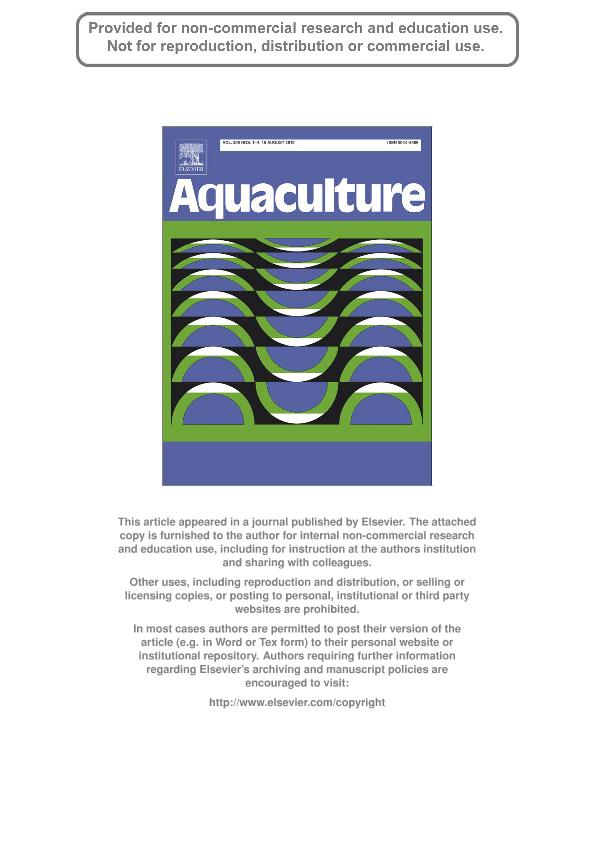Mostrar el registro sencillo del ítem
dc.contributor.author
Gregati, Rafael A.

dc.contributor.author
Fransozo, Vivian

dc.contributor.author
Lopez, Laura Susana

dc.contributor.author
Negreiros Fransozo, María Lucía

dc.date.available
2017-05-17T15:40:39Z
dc.date.issued
2010-08
dc.identifier.citation
Gregati, Rafael A.; Fransozo, Vivian; Lopez, Laura Susana; Negreiros Fransozo, María Lucía; Reproductive cycle and ovarian development of the marine ornamental shrimp Stenopus hispidus in captivity; Elsevier Science; Aquaculture; 306; 1-4; 8-2010; 185-190
dc.identifier.issn
0044-8486
dc.identifier.uri
http://hdl.handle.net/11336/16580
dc.description.abstract
The reproductive cycle and ovarian development of the marine ornamental shrimp Stenopus hispidus were described starting from adult mating pairs under laboratorial conditions. The pairs were individually kept in aquaria under constant conditions of salinity (35‰), temperature (26± 0.5 °C) and photoperiod (12L:12D). Molting, mating, spawning and hatching were recorded during three consecutive reproductive cycles. Females at different stages of ovarian development were anesthetized and their ovaries were removed, photographed, fixed and processed for histological examination. Mating occurred after female molting. Mean incubation time was 22.8± 2.1 days and mean intermolt periods were 25.5± 2.3 days for females and 26± 4.1 days for males. The ovaries varied in size and color during each reproductive cycle, which could be clearly seen through the transparent carapace. Spent ovary (translucent), lasted for 3 days after egg spawning; developing ovary (white), lasted 7 days; developed ovary (light green), between 5 and 8 days and advanced ovary (dark green) lasts 10 to 13 days. Microscopically, the ovarian stages differed in proportion of follicular cells, oocytes and oogonia. Follicular cells were abundant and mature oocytes were absent at the spent stage, while the number and size of secondary oocytes increased gradually thereafter. The present study indicates that S. hispidus can undergo multiple reproductive cycles under culture conditions. The changes in the macroscopic appearance of the ovary are strongly associated with the reproductive cycle.
dc.format
application/pdf
dc.language.iso
eng
dc.publisher
Elsevier Science

dc.rights
info:eu-repo/semantics/openAccess
dc.rights.uri
https://creativecommons.org/licenses/by-nc-nd/2.5/ar/
dc.subject
Reproducton
dc.subject
Ornamentals
dc.subject
Shrimp
dc.subject
Stenopus Hispidus
dc.subject.classification
Zoología, Ornitología, Entomología, Etología

dc.subject.classification
Ciencias Biológicas

dc.subject.classification
CIENCIAS NATURALES Y EXACTAS

dc.title
Reproductive cycle and ovarian development of the marine ornamental shrimp Stenopus hispidus in captivity
dc.type
info:eu-repo/semantics/article
dc.type
info:ar-repo/semantics/artículo
dc.type
info:eu-repo/semantics/publishedVersion
dc.date.updated
2017-05-15T21:08:07Z
dc.journal.volume
306
dc.journal.number
1-4
dc.journal.pagination
185-190
dc.journal.pais
Países Bajos

dc.journal.ciudad
Amsterdam
dc.description.fil
Fil: Gregati, Rafael A.. Universidade Estadual Paulista Julio de Mesquita Filho; Brasil
dc.description.fil
Fil: Fransozo, Vivian. Universidade Estadual Paulista Julio de Mesquita Filho; Brasil
dc.description.fil
Fil: Lopez, Laura Susana. Universidad de Buenos Aires. Facultad de Ciencias Exactas y Naturales. Departamento de Biodiversidad y Biología Experimental; Argentina. Consejo Nacional de Investigaciones Científicas y Técnicas; Argentina
dc.description.fil
Fil: Negreiros Fransozo, María Lucía. Universidade Estadual Paulista Julio de Mesquita Filho; Brasil
dc.journal.title
Aquaculture

dc.relation.alternativeid
info:eu-repo/semantics/altIdentifier/doi/http://dx.doi.org/10.1016/j.aquaculture.2010.05.009
dc.relation.alternativeid
info:eu-repo/semantics/altIdentifier/url/http://www.sciencedirect.com/science/article/pii/S0044848610003182
Archivos asociados
